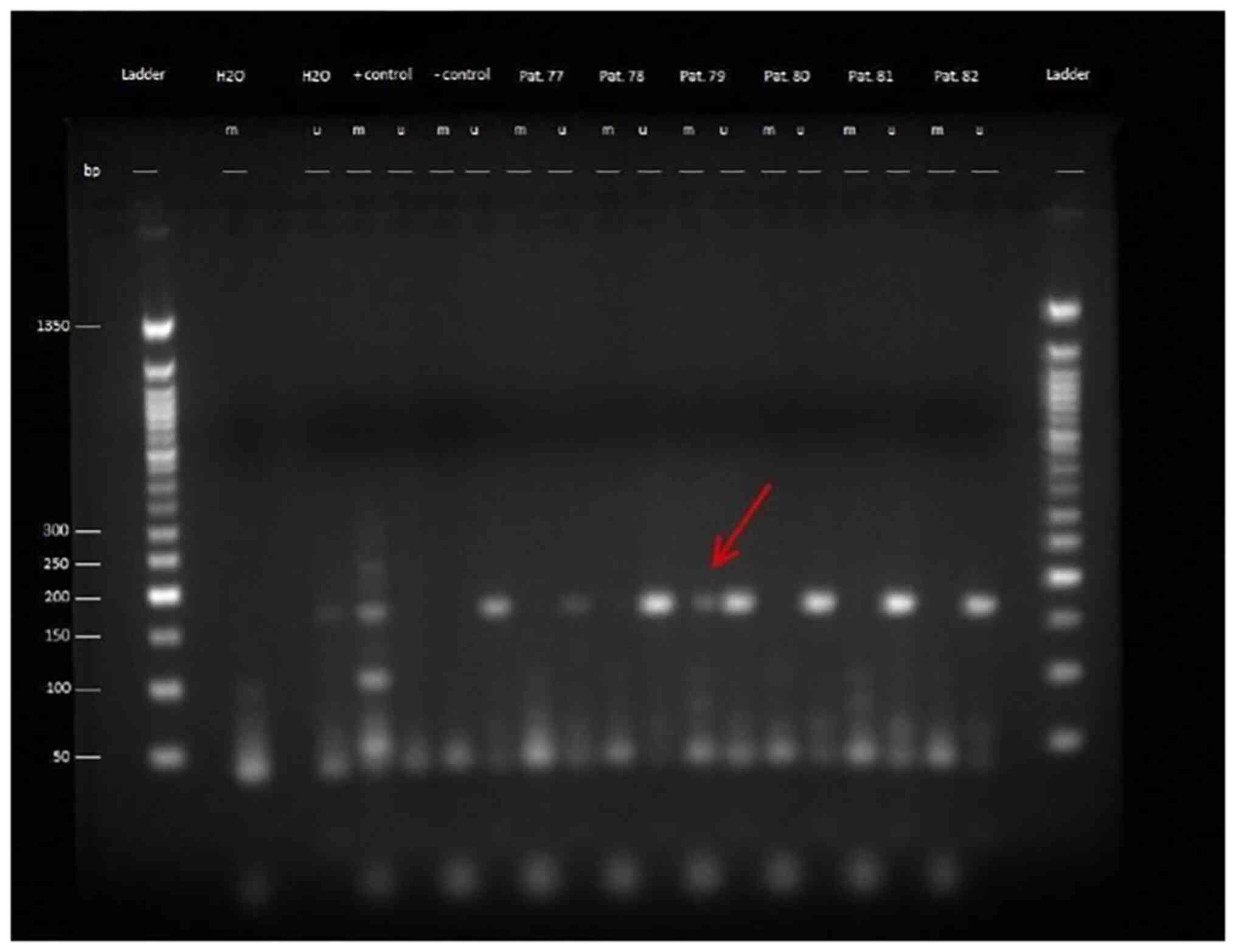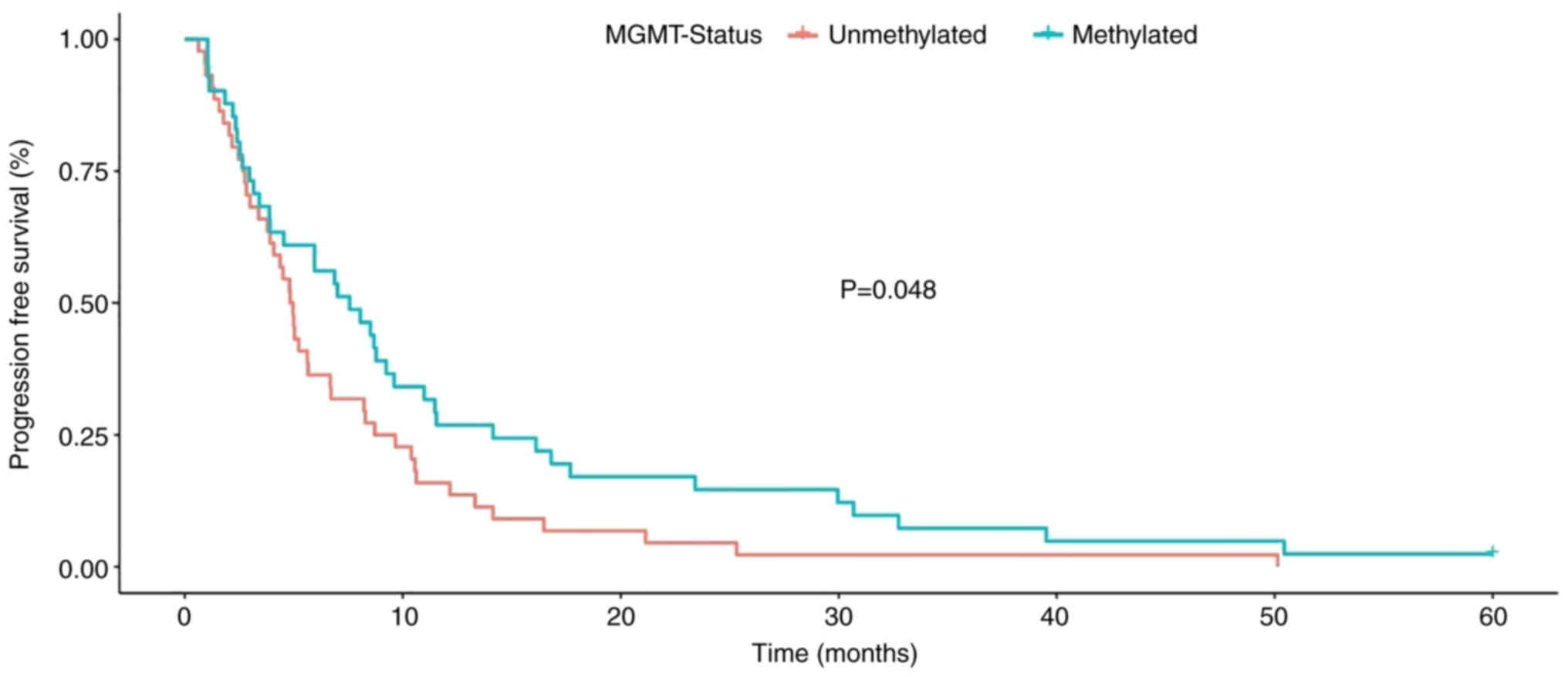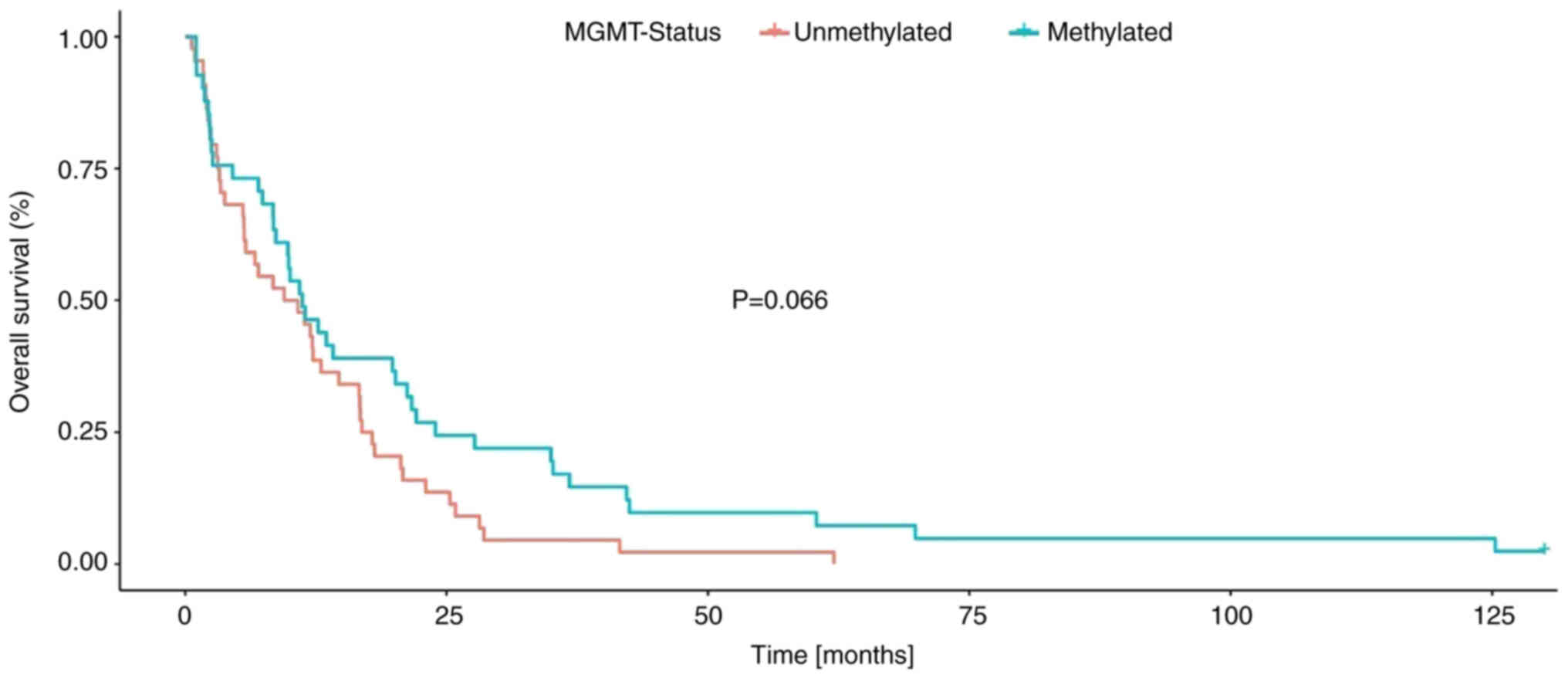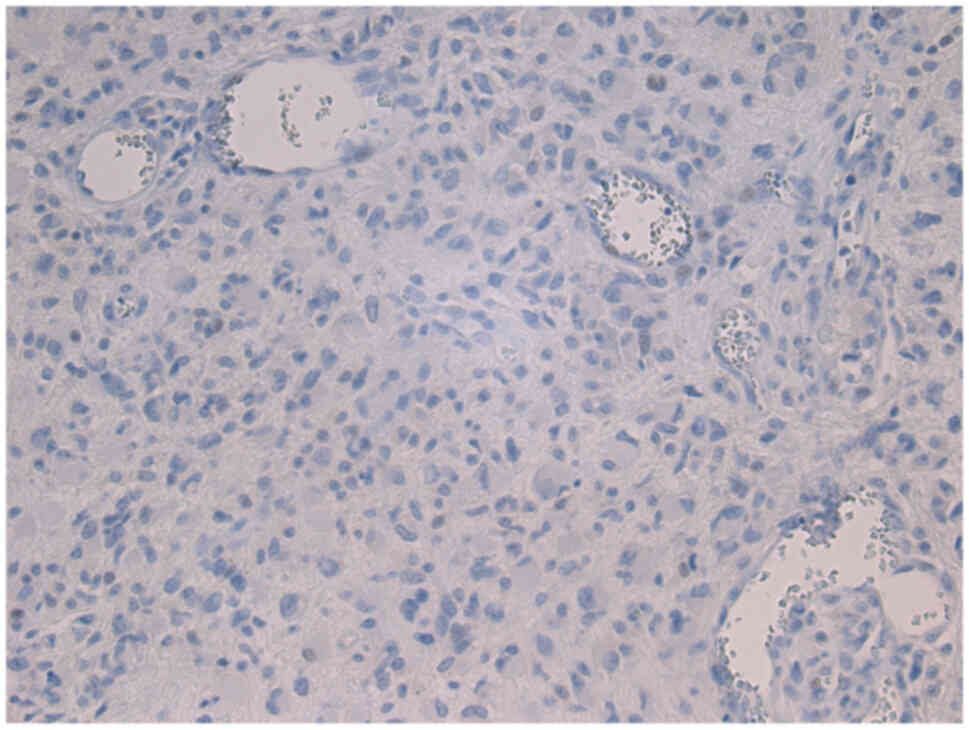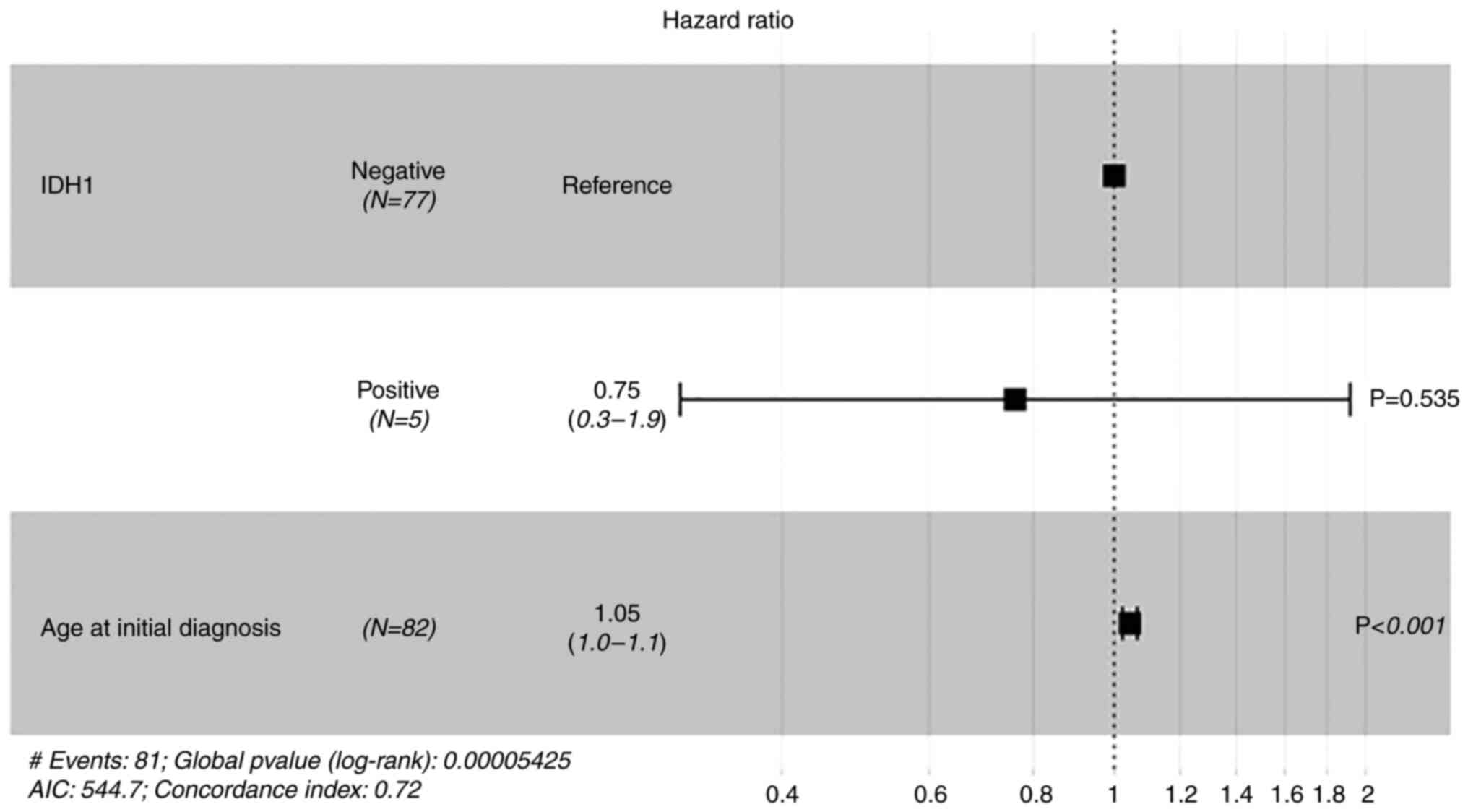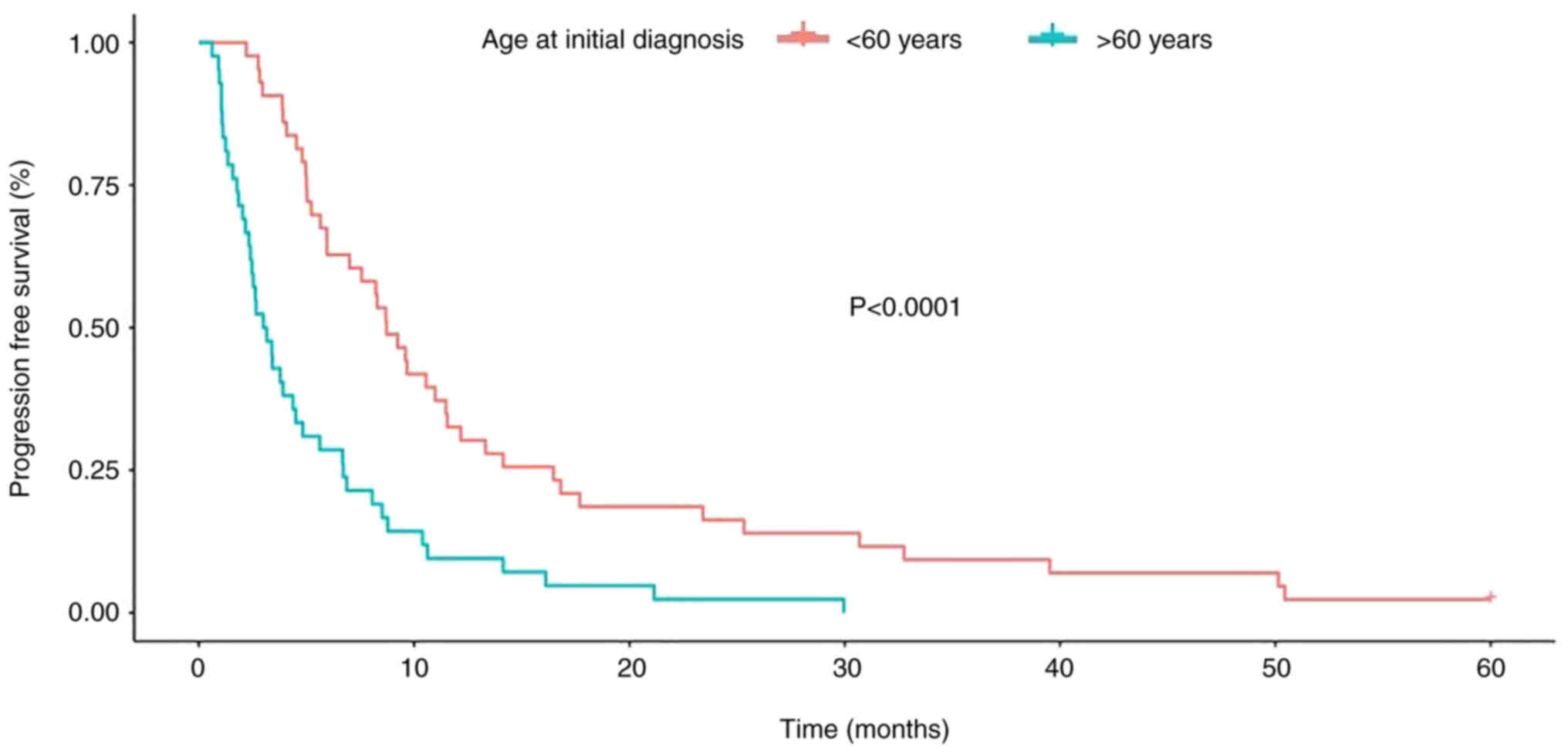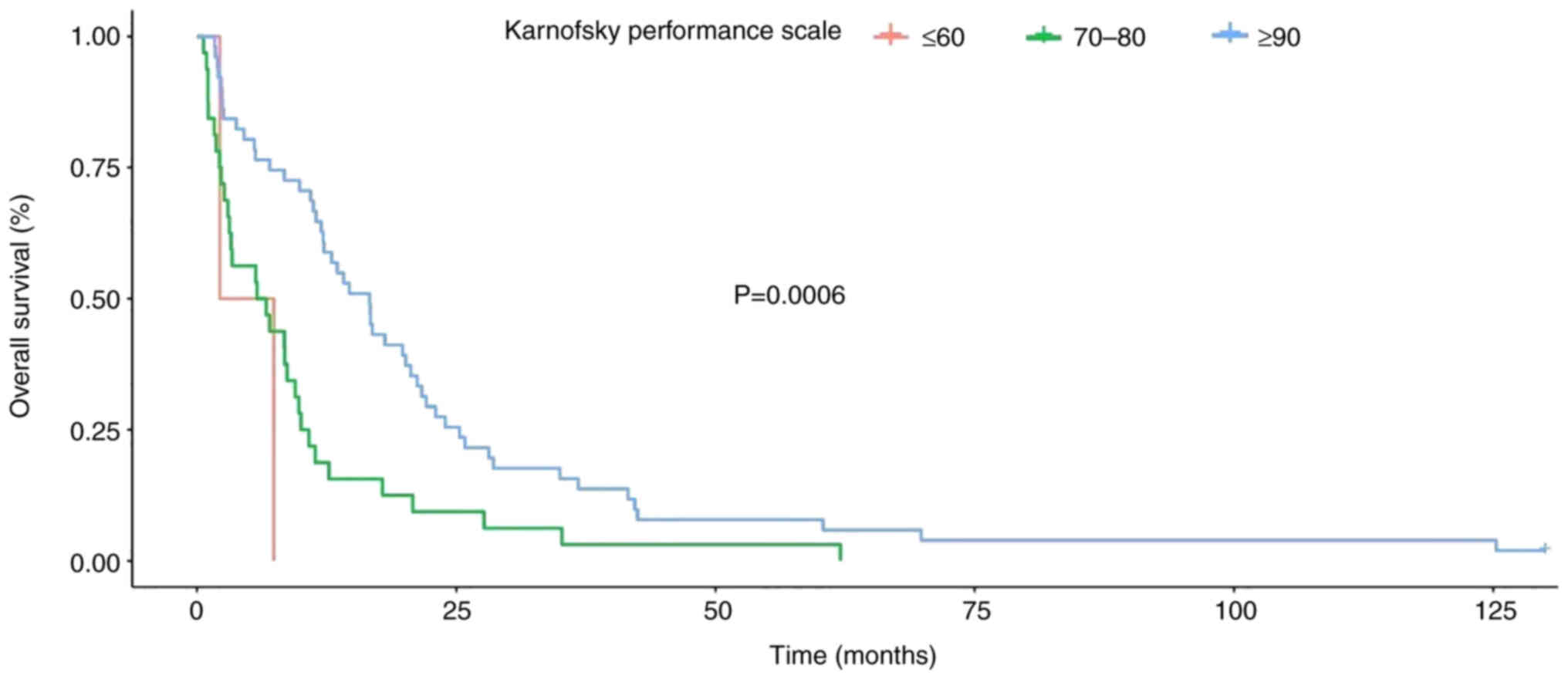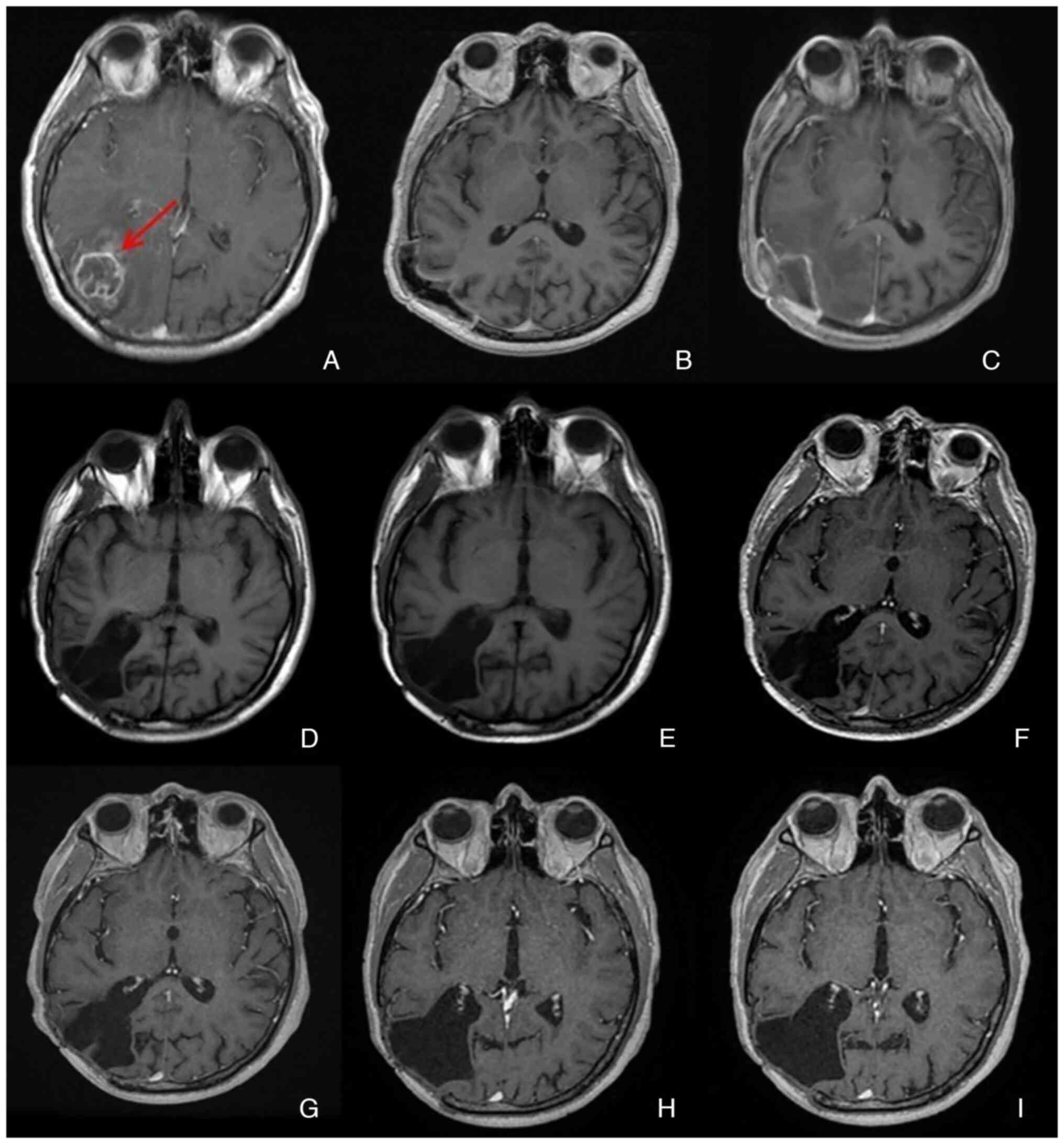RB1‑promoter methylation in glioblastoma: A rare event in glioblastoma
- Authors:
- Published online on: June 2, 2023 https://doi.org/10.3892/or.2023.8580
- Article Number: 143
-
Copyright: © Urbschat et al. This is an open access article distributed under the terms of Creative Commons Attribution License.
Abstract
Introduction
Glioblastoma are a highly aggressive and the most common type of primary central nervous system tumor in adults (1). According to the 2021 classification of the World Health Organization (WHO), glioblastoma are mainly classified according to the status of isocitrate dehydrogenase (IDH), IDH1 wildtype and IDH1 mutant, and correspond to a grade 4 astrocytoma (1).
The development of glioblastoma is often the result of an accumulation of genetic changes and dysregulation of signaling cascades, which lead to the uncontrolled proliferation of tumor cells. Methylation is considered the most common and one of the most important epigenetic mechanisms (2). It serves an essential role in embryogenesis, X-inactivation, genomic imprinting, regulation of gene expression and carcinogenesis (2). Catalysis of the methylation reaction, in which 5-methylcystocine is formed from cytosine and a methyl group at position C5 of its pyrimidine ring, is performed by DNA methyl transferases and S-adenosylmethionine acts as a methyl donor and cofactor in the reaction (3). Unmethylated, deaminated cytidines are converted to uracil, which will lead to both incorrect implantation in the DNA-sequence and elimination of this error by the DNA repair system. However, methylated cytidines (5′-methylcytidine) are converted to thymine by deaminases, which avoids recognition of the error by the DNA repair system. Consequently, this part of the DNA will be deactivated, which leads to silencing of the gene and loss of expression (3).
DNA methylation can be reversed in both active and passive ways. Passively it can be reversed in the absence of functional DNA methyltransferase 1 (DNMT1)/UHRF1 proteins during DNA replication. Actively, there are oxidation-dependent and oxidation independent DNA methylation mechanisms (4). Regarding the oxidation dependent mechanism, the enzymatic methylation removal and loss of methylated cytosines following nucleotide excision repair, and the deamination of methylated cytosine and the subsequent repair mechanisms can both lead to demethylation. The oxidation dependent mechanisms include the oxidation of methylated cytosines by TET proteins and the subsequent involvement of DNMT1/UHRF1, as well as other ways including DNA repair mechanisms which remove modified methylated cytosine. Furthermore, dehydroxymethylation by DNMTs and decarboxylation of 5caC (5-carboxylcytosine) can lead to the removal of the methyl group (4). In humans, the methylation reaction occurs exclusively at the cytosine nucleotides within CpG dinucleotides in the direction of 5′-CpG-3′. CpG dinucleotides are particularly abundant in repetitive DNA sequences or in CpG islands. While 70% of all CpG dinucleotides are methylated, CpG islands are an exception (2) and are often part of the promoter regions of genes and are usually unmethylated. Methylations of promoter regions are associated with gene silencing (3). This is of particular interest when transcriptional gene silencing prevents the expression of tumor suppressor genes and thus allows development of a tumor (2).
The RB1 gene is a tumor suppressor gene located on chromosome 13q14.1-q14.2 (5), which consists of ~200 kb DNA including 27 exons and encodes retinoblastoma protein (pRB), a nuclear phosphoprotein, which consists of 928 amino acid residues. pRB is involved in the regulation of the cell cycle, cell differentiation and the initiation of apoptosis (6). The RB1 gene has been known for a long time and serves an important role in numerous tumor diseases. The function of RB1 is to interrupt the cell cycle at the transition of G1 to S phase (7). Regulation of the activity of pRB occurs via its phosphorylation status: While pRB is unphosphorylated in G0 and early G1 phase, it is phosphorylated as the cell cycle approaches the G1-S transition, it then remains in this state until it is dephosphorylated again in late M phase (8). Its role in glioblastoma has also been previously reported by numerous studies. As a tumor suppressor gene, RB1 is complexly linked to numerous other genes and factors in its signaling pathway and modifications of the RB1 signaling pathway also serve an important role in glioblastoma.
It has been previously reported that ~30% of all malignant astrocytomas had loss of heterozygosity (LOH) of the RB1 gene, whereas this was not observed in low-grade astrocytomas (9). Thus, loss of function of RB1 contributes to the upgrading from low-malignant to high-malignant astrocytomas (10). Alteration of the cyclin dependent kinase inhibitor 2A (CDKN2A), a tumor suppressor gene located on human chromosome 9p21 which acts as a negative regulator of the cell cycle (11), or RB1 gene due to mutations or LOH can often be found in glioblastomas, in most cases only one of the genes is affected (12,13). Ichimura et al (13) reported that 64% of the 120 glioblastoma cases assessed, had gene alterations, which caused a disturbance in cell cycle control at the G1-S transition. The same study reported that in 30% of cases, loss of one allele of the CDKN2A or RB1 gene occurred, and in only 6% of cases were both genes unchanged. Alterations in the CDKN2A gene were quite common, occurring in 40% of all glioblastomas, and the RB1 gene was altered in 14% of the cases.
The role of RB1 promoter methylation in glioblastoma is controversial and the literature contains partly contradictory statements. Numerous studies have been performed previously and they have yielded different results. To the best of our knowledge, the present study is the first on this topic which classified glioblastomas according to the current, 2016 version of the WHO Classification of Tumors of the Central Nervous System (14). The intention of the present study was to examine a defined collective of patients with glioblastoma, which was large as possible, to support a general statement on the relevance of RB1 methylation in glioblastoma and to evaluate the impact of methylation on clinical parameters.
Materials and methods
Patients and tissue specimens
All primary glioblastoma tumors (n=85) were obtained following surgical resection at the Saarland University Medical Center (Homburg, Germany) between 2003 and 2013 as part of routine clinical care. Tumors were subsequently examined histologically by a neuropathologist and the diagnosis was made according to the 2016 WHO classification (14). All samples were collated in the Institute of Human Genetics at the Saarland University Medical Center and tissue samples were frozen in cryo tubes at −80°C directly following surgery. The tissue samples were removed from −80°C storage from 2013, the beginning of the present study. The present study was approved by the Ethics Committee of the General Medical Council of the State Saarland (43/99) and informed consent for participation was obtained from all participants involved in the study.
DNA isolation
DNA was extracted from the frozen samples of glioblastoma. The tumor tissue was minced using forceps and scissors, according to previously published methods (15). The DNA was dissolved in distilled water overnight at 4°C and then a photometric concentration determination was performed using a NanoDrop 2000/2000c spectrophotometer (Thermo Fisher Scientific, Inc.).
Bisulfite treatment
After the DNA was isolated, double stranded DNA concentrations were assessed for bisulfite conversion. The isolated DNA was mixed with sterile water for injection and adjusted to 25 ng/µl. Bisulfite conversion was performed using an EZ DNA Methylation-Gold kit (Zymo Research Corp.) according to the manufacturers' instructions. The probes were transferred into the PTC-100 Thermal Cycler (MJ Research, Inc.; Bio-Rad Laboratories, Inc.). Afterwards the treatment was continued using the Kit according to the manufacturers' protocol.
Methylation-specific PCR (MS-PCR)
The MS-PCR method was developed in 1996 by Herman et al (16). In contrast with typical PCR, in MS-PCR, two pairs of primers are used instead of one. The first primer pair is used to amplify the DNA sequence of a methylated RB1-promoter. The second primer pair is then used to amplify the DNA sequence of an unmethylated RB1 promoter. For the analysis of the methylation status of a tumor sample, it is necessary to set up two PCR assays with tumor DNA, and amplification of the DNA occurs in only one of the two assays. Three controls were used, including a positive control which contained methylated DNA (Zymo Research Corp.) and a negative control, in which unmethylated DNA from a male donor was used. According to the manufacturer, these positive controls were Human HCT116 DKO methylated DNA and were appropriate for use as a positive control for DNA methylation analysis. As a final control, distilled water served to test the master mix for contamination. The sequences of the primers used in the MS-PCR of the RB1 gene were as follows (17,18): Methylated (m)RB1 forward (F), 5′-GGGAGTTTCGCGGACGTGAC-3′ and reverse (R), 5′-ACGTCGAAACACGCCCCG-3′; and unmethylated (u)RB1 F, 5′-GGGAGTTTTGTGGATGTGAT-3′ and R, 5′-ACATCAAAACACACCCCA-3′. The sequences of the primers used in the MS-PCR of O-6-methylguanine-DNA methyl transferase (MGMT), first reported by Esteller et al (19), were as follows: uMGMT F, 5′-TTTGTGTTTTGATGTTTGTAGGTTTTTGT-3′ and R, 5-AACTCCACACTCTTCCAAAAACAAAACA-3′; and mMGMT F, 5′-TTTCGACGTTCGTAGGTTTTCGC-3′ and R, 5′-GCACTCTTCCGAAAACGAAACG-3′. Primers were synthesized by Eurofins Genomics Germany GmbH from the aforementioned, cited sequences.
Each PCR assay consisted of a master mix and DNA (25 ng/µl) in an Eppendorf PCR tube. The master mix comprised distilled water, taq-buffer (15 mM), forward primer (m/u, 4 pmol), reverse primer (m/u, 4 pmol), dNTP (10 mM) and taq-polymerase (5 U/µl). A hot-start PCR with 38 PCR cycles was performed using a PTC-100 thermocycler (MJ Research, Inc.; Bio-Rab Laboratories, Inc.). The thermocycling conditions were as follows: Preheating at 95°C for 15 min to activate the polymerase, then DNA denaturation at 95°C for 45 sec, primer hybridization at 55°C for 45 sec and elongation at 72°C for 1 min.
In the Neurosurgery Department of the Saarland University Medical Center in collaboration with the Neuropathology Department in the Saarland University Medical Center every tumor is diagnosed according to WHO recommendations; therefore, the 85 tumor samples were tested for methylation of the MGMT gene as a standard tool, for all GBM patients (19,20). DNA isolation was performed using a QIAamp DNA Mini kit 50 DNA isolation kit (Qiagen N.V.). The methylation status of MGMT was determined by MS-PCR.
Agarose gel electrophoresis
The reverse transcription MS-PCR products were evaluated using standard 2.5% agarose gel electrophoresis stained with ethidium bromide and visualized under ultraviolet illumination to evaluate the reverse transcription MS-PCR results. To perform the electrophoresis, an electric field with a potential difference of 135 V and a current of 260 mA was applied for two h. The bands were assessed based on their presence on the gel at 93 bp and 89 bp for unmethylated and methylated MGMT (O-6-Methylguanine-DNA Methyl transferase) promoter sequence, respectively.
IDH1 immunohistochemistry
Determination of IDH1 status was performed in all patients, except three who were excluded due to lack of-sample material. For the determination of the IDH1 mutation status, the indirect, two-step antibody method with an IDH1 R132H primary antibody, which could detect the most common IDH1 mutation R132H was used.
Immunohistochemistry was performed using 3 µm thick formalin-fixed (fixed in 4% buffered formaldehyde at room temperature for 24 h), paraffin-embedded (FFPE) tissue sections were mounted on StarFrost Advanced Adhesive slides (Engelbrecht Medizin-und Labortechnik GmbH), followed by drying at 80°C for 15 min. Deparaffinisation took place in xylene and sections were rehydrated in a descending isopropanol series. Sections were incubated with primary antibodies against R123H mutated isocitratdehydrogenase 1 (1:50; cat. co. dia-H09; Dianova GmbH) for 30 min. The DAKO REAL kit (cat. no. K5007; Dako; Agilent Technologies, Inc.) was used according to manufacturers' instructions, for the visualization of the antigen-antibody reaction with HRP/DAB.
Statistical analysis
Statistical analysis of the data were performed using R software R 3.5.2 (www.r-project.org). The R-packages called ‘Survival’, ‘survminer’ and ‘openxlsx’ were used. The Kaplan-Meier method was used to estimate the survival rates, and the Cox regression was applied to compare the survival differences among the patients. Progression-free survival (PFS) was defined as the time from treatment start date until objective tumor progression or death. Overall survival (OS) was calculated from the date of initial surgery until the date of death or last follow-up. OS was defined as the time from treatment to death, regardless of disease recurrence. The other potential prognostic variable was the Karnofsky score (21). The confidence interval was set at 95% and the significance level was set at P<0.05.
Results
Real-time MS-PCR
Methylation analysis of the RB1 gene was performed on glioblastomas isolated from 85 patients. RB1 methylation was identified in 1/85 patients (1.18%). Of the 85 patients included in the present study, at the time of the last observation (December 2019), 84 patients had died from the disease, while one patient (patient 79) was alive and tumor-free. Patient 79 was also the only patient with an RB1 methylation and the solely sole survivor of the present study.
The products of the MS-PCR were evaluated by gel electrophoresis using a 2.5% agarose gel, which was examined under UV light (Figs. 1 and S1). The length of the PCR products for the methylated and the unmethylated approach were 172 bp. The bands in the gel were therefore to be expected between the 150 bp band and the 200 bp band of the DNA ladder. It was demonstrated that patients with methylated MGMT promoter had a markedly longer survival. This relationship was statistically significant in relation to PFS (P=0.048, Fig. 2), but not in relation to OS (P=0.066, Fig. 3, Table I).
An R132H mutation of IDH1 (Figs. 4 and 5) was identified in five patients (6.10%). A Cox regression analysis was performed with the variables age, IDH1 status and overall survival (Fig. 6). This demonstrated that there was a significant (P<0.001) association of low age at initial diagnosis and longer survival however, no significant association with IDH1 was demonstrated. With a case number of n=5 for IDH1 mutation, further statistical analysis was considered to not be meaningful.
Clinical results
Kaplan-Meier analysis and Cox regression analysis were performed to analyze the clinical parameters. When evaluating the values using the Kaplan-Meier curve, the log-rank test was used to determine the P-value. Numerous factors and their influence on patient survival were assessed in terms of both PFS and OS. The median OS in the study population was 15.7 months. The shortest OS was 0.62 months and the longest, with the exception of the patient who was still alive, was 125.29 months. The 95% confidence interval was 15±3.83 months with a standard deviation of 18.73 months. The median PFS was 9.0 months; the shortest PFS was 0.62 months, and the longest PFS was 50.43 months. The 95% confidence interval was 9±2.13 months with a standard deviation of 10.12 months. The median age of the patient population at initial diagnosis was 59.6 years (range, 35–82 years). Kaplan-Meier analysis demonstrated a significant reduction in both OS and PFS with an increased age (>60) at initial diagnosis. With a calculated median age at diagnosis of 59.6 years, a cutoff of 60 years of age was used to compare the survival of patients >60 years (n=42) with those <60 years (n=43). In both the analysis of OS and PFS, a worse prognosis was demonstrated in the group of patients >60 years (Figs. 7 and 8).
It was demonstrated that patients with a high Karnofsky score at the time of initial diagnosis had a significantly better OS rate and there was a significant prolongation of both OS and PFS (Fig. 9).
Illustrative case
A statistical evaluation of RB1 methylation was not reasonable with only a single case, therefore the case in which a methylation of the RB1-promoter was detected is presented as a case report.
Patient 79 was the only patient in the present study whose tumor demonstrated RB1-promoter methylation. Patient 79, born in 1958, was diagnosed in December 2012 following progressive right-sided headache, occasional nausea and photosensitivity. Radiological imaging was performed using computed tomography. A parieto-occipital mass was identified and glioblastoma was suspected. Subsequent magnetic resonance imaging revealed a multi-cystic lesion with extensive perifocal edema extending to the frontal and occipital regions. The mass showed a strong, marginal enhancement after contrast application. There was also a midline shift of approximately 7 mm, to the left. Locally, the outer cerebrospinal fluid spaces were effaced. The patient did not have any known history of tumor disease. A Karnofsky score of 100 was calculated (21). Neurologic examination demonstrated a slightly smaller right pupil compared with the left; however, both pupils were indirectly and directly light reactive. Assessment of the visual field showed a hemianopsia on the left side, the remaining cranial nerve status was unremarkable. There were no sensory motor deficits in the extremities and, the intrinsic muscle reflexes were side-to-side and unremarkable. Bladder and rectum function was intact. A right occipital osteoclastic craniotomy and tumor resection was performed using a microsurgical technique under neuronavigational guidance including an insertion of Carmustine wafers into the tumor cavity. The intraoperative course was completed without complications. During which, glioblastoma was confirmed histopathologically. Further pathologic diagnosis resulted in the detection of the cell proliferation markers, Microtubule-Associated Protein 2, Phophorylated Histone H and Glial Fibrillary Acidic Protein. The Ki67 proliferation index was 60% (high index ≥20%). Methylation of the MGMT-promoter was present. IDH-1 mutation status was negative. Postoperative computed tomography scan of the head demonstrated good tumor resection with no evidence of postoperative bleeding. The patient received analgesia as needed and antithrombotic prophylaxis. Postoperatively, the neurological status was unchanged, with no evidence of new neurological deficits. Due to the Carmustine wafer insertion into the tumor cavity, the patient received anti-edematous therapy with 8 mg dexamethasone 4 times daily for 4 weeks, as recommended (22). In January 2013, the bone flap became infected and had to be removed. With cerebrospinal fluid leaking due to a dura defect, an external ventricular drain had to be implanted. In April 2013 an epidural abscess was detected and an abscess removal had to be performed. Treatment was performed according to the Stupp protocol (23) from February 2013 and was discontinued in September 2013 after completion of the 6th cycle of Temozolomide chemotherapy. Adjuvant radiotherapy of the tumor region according to the protocol amounted to a total radiation dose of 60 Gy with simultaneous chemotherapy with Temozolomide (75 mg/m2 body surface area). Subsequently, scheduled follow-up examinations were performed at 3 month intervals. Including the last follow-up in 12/2019, the clinical condition has been stable since then. MRI scans performed for radiological control also demonstrated stable findings without tumor remnant or tumor recurrence (Fig. 10).
Discussion
Gliomas are characterized by global changes in DNA methylation. They are usually triggered by IDH mutation and this mutation can affect both DNA methylation and histone modifications (24). Changes in DNA methylation in gliomas have been previously reported to modify the binding affinity of numerous transcription factors such as HOX and CCCTC-binding factor (CTCF) (24). IDH-1 methylations are most likely early events in the tumor genesis and can lead to DNA methylation and therefore silencing of genes, such as tumor suppressors, including Rb1 (25). Furthermore, the R132H-mutation in IDH-1 can lead to increased formation of the D-2-Hydorxygultarate (inhibitor) and decreased levels of α-ketoglutarate (cofactor for histone and DNA demethylases) by inactivation of the isocitrate dehydrogenase (26). In summary, this is defined by three main steps. First, mutant IDH1 produces 2-Hydroxyglutatrate from α-ketoglutarate, then 2-Hydroxyglutatrate inhibits histone and DNA demethylases, which leads to an increase in methylation levels. Finally, methylation to CTCF in the DNA inhibits CTCF binding and induces rearrangement of the topologically associating domains (26).
The RB1 tumor suppressor gene has been implicated in the pathogenesis of numerous neoplastic diseases such as retinoblastoma and small cell lung cancers (27). However, to the best of our knowledge, there has not previously been a conclusive statement about the role of RB1 promoter methylation in Glioblastoma, due to partly contradictory results. In the present study, a methylation analysis of the RB1 promoter was performed using bisulfite conversion, MS-PCR and gel electrophoresis on a total of 85 primary glioblastoma samples from 85 patients. Methylation of the promoter of RB1 was identified in only one patient, which corresponded to a methylation rate of 1.18%.
Epigenetic modifications of the genetic material are part of the genesis of most tumors and also serve an important role in glioblastoma (28). RB1, together with E2F, p53, CDK4/6, and CDKN2A, is part of a regulatory circuitry that controls cell division, differentiation, senescence and apoptosis (28,29). In the present study, methylation of the RB1-promoter was demonstrated (1/85; 1.18%) which indicated that RB1 promoter methylation did not appear to be a relevant event in the development and progression of glioblastoma. Previous studies reported partially divergent results in this regard. The two studies with the largest numbers of cases of RB1 methylation in glioblastoma, are by Nakamura et al (30) from 2001 (n=56) and Gonzalez-Gomez et al (31) in 2003 (n=42). Nakamura et al evaluated the methylation status of the RB1 promoter in 56 patients and identified a methylated promoter in a total of 14 patients, which corresponded to 25% of the cases examined, markedly higher than in the present study. They also subdivided glioblastomas into primary and secondary according to the older WHO classification (30) and reported that promoter methylation was significantly more common in secondary (43%) than primary (14%) glioblastomas (30). A lower proportion of detected RB1 methylation was consistent with the results of Nakamura et al; however, the proportion in the present study was markedly reduced at 1.18%. The WHO classification (2016) was used in the present study, which no longer classifies glioblastomas as primary or secondary. Rather, glioblastomas are classified according to IDH-1 mutation status. According to the 2016 WHO classification, all of the tumors included in the present study were classified as glioblastomas, however it is possible that some of the included samples in the study by Nakamura et al, classified according to the 2000 WHO classification, would no longer be classified as glioblastomas. Methodologically, Nakamura et al used MS-PCR following bisulfite conversion, which was performed using the CpGenome DNA Modification Kit (Intergen Health). The primers used were the same as those used in the present study. Gel electrophoresis was also performed as in the present study with a 3% agarose gel using ethidium bromide for visualization (30). It can be summarized that, except for the use of a different kit, in general the same methods were used as in the present study.
The second large, previous study, which focused on RB1 promoter methylation in glioblastoma, was performed by Gonzalez-Gomez et al in 2003 in the University Hospital of La Paz in Madrid (31). The study included, among other tumor entities of the central nervous system, 42 glioblastomas. RB1 promoter methylation was identified in 9 of the 42 tumors, corresponding to a rate of 21%. As reported by Nakamura et al, a higher methylation rate was demonstrated in secondary glioblastomas compared with primary glioblastomas. The study included 32 primary and 10 secondary glioblastomas, with 15% being of the primary (5/32 tumors) and 40% of the secondary glioblastomas (4/10 tumors) being methylated. Gonzalez-Gomez et al hypothesized that the hyper methylation of the RB1 promoter represented a common epigenetic event that was associated with the development of brain tumors (31). This contradicted the results of our study where RB1-methylation was identified in only 1.18% of cases. It must be noted again that in the present study a lower rate of RB1-methylated tumors was to be expected because the present study exclusively investigated primary glioblastomas (according to the previous WHO system), however, the percentage of RB1-methylated tumors (1.18%) was markedly lower than that reported by Gonzalez-Gomez et al (15%). Similar to Nakamura et al, Gonzalez-Gomez et al used the older version of the WHO classification with a markedly lower initial number of cases. The methods used by Gonzalez-Gomez et al were similar to those used in the present study.
In another study in 2002, Yin et al evaluated the p14, p15, p16 and RB1 genes in patients with brain tumors. In this study, Yin et al also used MS-PCR following bisulfite conversion, which was performed using the CpGenome DNA Modification kit (Intergen Health). None of the 30 glioblastomas examined demonstrated RB1-methylation (32). These results were similar to those of the present study, although Yin et al (32) investigated a smaller number of cases (n=30). Due to the low incidence of methylation of RB1 and also p15INK4B and p16INK4A gene (4 and 7%), they concluded that the methylation of these genes served a minor role in the development of brain tumors in general (32). Based on the results of the present study for RB1 methylation in 85 patients, the present study supports the hypothesis that methylation of the RB1 gene does not seem to serve a major role in the development of glioblastoma.
Yu et al (33) also evaluated the methylation status of genes involved in the development of astrocytomas. Among others, 12 Glioblastomas were included in the tumors evaluated. In addition to p14ARF and p15INK4b, no methylation was detected in the RB1-gene in any of the glioblastomas. As in the previous studies, the same methods were used as in the present study (33). Another study dealing with the promoter methylation of cell cycle control genes was reported by Ohta et al in 2006 on malignant astrocytomas (34). The study group included 31 glioblastomas and 23 anaplastic astrocytomas. In addition to RB1, p14ARF, p15INK4b, p16INK4a, p21Waf1/Cip1, p27Kip1 and p73 were also assessed. Methylation of the RB1 promoter was identified in three of the tumors, which corresponded to ~6% of the tumors examined; however, no differentiation was made between glioblastomas and anaplastic astrocytomas. While ~50% of the tumors showed an abnormal promoter methylation pattern for at least one of the genes examined, none of the tumors had three or more genes affected. Interestingly, there was no significant association between the methylation status of the genes with clinicopathological parameters. The methylation status of the genes had no effect on PFS or OS, either individually or in combination. Ohta et al thus concluded that promoter methylation served only a minor role in relation to the development of malignant brain tumors. This was consistent with the findings of the present study with respect to RB1.
Genes of the RB1 signaling pathway and their expression in astrocytomas were the focus of a study performed by Ferreira et al in 2015 (35). From 58 analyzed samples, 23 were glioblastomas. Methylation of the RB1 promoter was not detected in any of the samples. Compared with the present study and the other aforementioned studies, the methodology was different as Ferreira et al used bisulfite sequencing, DNA sequencing following bisulfite conversion (35,36). However, despite a different method, the present study demonstrated a result which was in agreement with the findings of Ferreira et al (35). A recent study, which performed gene sequencing of 63 IDH-wild type glioblastomas (classified as glioblastoma grade IV tumors), reported that focal homozygous RB1 deletion was present in only seven cases (11.10%) (37).
In conclusion, the present study demonstrated that methylation of the RB1 promoter was not a relevant event in the development and progression of glioblastoma. This was because it was a very rare event in glioblastoma patients, with only one of 85 patients showing a methylation of the RB1 promoter. The same patient was also the only survivor from the patients included in the present study. However, this can only be reported as a case report and could not be assessed statistically.
Supplementary Material
Supporting Data
Acknowledgements
The authors wish to thank Professor Klaus-Dieter Zang, previous Head of the Human genetic department for his academic support. The authors wish to thank Sigrid Welsch, our technician in the neurosurgery laboratory, for her technical assistance. The authors wish to thank Dr Kettern Julia and Dr Jürgens-Wemheuer Wiebke from the neuropathology department for the MGMT gel image.
Funding
Funding: No funding was received.
Availability of data and materials
The datasets used during the present study are available from the corresponding author upon reasonable request.
Authors' contributions
The study was conceptualized by SU. SU and GB onfirm the authenticity of all the raw data. The methodology was established by CS. Statistical evaluation was performed by CS. Acquisition and validation of clinical data was performed by RK. Formal analysis of the data were performed by GB and WSS. Methodical proceedings, GB. Resources, JO. Data curation was performed by GB. The original draft of the manuscript was written by MH and review and editing was performed by SU. Supervision was provided by RK, JO and SU. Project administration was performed by RK. All authors have read and agreed to the published version of the manuscript.
Ethics approval and consent to participate
The present study was performed according to the guidelines of the Declaration of Helsinki and approved by the Ethics Committee of the General Medical Council of the State Saarland (approval no. 43/99). Informed consent for participation was obtained from all subjects involved in the study.
Patient consent for publication
Informed consent for publication was obtained from all subjects involved in the study.
Competing interests
The authors declare that they have no competing interests.
Glossary
Abbreviations
Abbreviations:
|
WHO |
World Health Organization |
|
IDH |
isocitrate dehydrogenase |
|
DNMT1 |
DNA methyltransferase 1 |
|
5caC |
5-carboxylcytosine |
|
RB1 |
retinoblastoma gene |
|
pRB |
retinoblastoma protein |
|
LOH |
loss of heterozygosity |
|
CDKN2A |
cyclin dependent kinase inhibitor 2A |
|
MS-PCR |
methylation-specific PCR |
|
MGMT |
O-6-methylguanine-DNA methyl transferase |
|
PFS |
progression-free survival |
|
OS |
overall survival |
|
CTCF |
CCCTC-binding factor |
|
cMRI |
cerebral Magnetic Resonance Imaging |
References
|
Sturm D, Witt H, Hovestadt V, Khuong-Quang DA, Jones DTW, Konermann C, Pfaff E, Tönjes M, Sill M, Bender S, et al: Hotspot mutations in H3F3A and IDH1 define distinct epigenetic and biological subgroups of glioblastoma. Cancer Cell. 22:425–437. 2012. View Article : Google Scholar : PubMed/NCBI | |
|
Strichman-Almashanu LZ, Lee RS, Onyango PO, Perlman E, Flam F, Frieman MB and Feinberg AP: A genome-wide screen for normally methylated human CpG islands that can identify novel imprinted genes. Genome Res. 12:543–554. 2002. View Article : Google Scholar : PubMed/NCBI | |
|
Gill RM, Hamel PA, Zhe J, Zacksenhaus E, Gallie BL and Phillips RA: Characterization of the human RB1 promoter and of elements involved in transcriptional regulation. Cell Growth Differ. 5:467–474. 1994.PubMed/NCBI | |
|
Wu H and Zhang Y: Reversing DNA methylation: Mechanisms, genomics, and biological functions. Cell. 156:45–68. 2014. View Article : Google Scholar : PubMed/NCBI | |
|
Sparkes RS, Murphree AL, Lingua RW, Sparkes MC, Field LL, Funderburk SJ and Benedict WF: Gene for hereditary retinoblastoma assigned to human chromosome 13 by linkage to esterase D. Science. 219:971–973. 1983. View Article : Google Scholar : PubMed/NCBI | |
|
Sellers WR and Kaelin WG Jr: Role of the retinoblastoma protein in the pathogenesis of human cancer. J Clin Oncol. 15:3301–3312. 1997. View Article : Google Scholar : PubMed/NCBI | |
|
Sherr CJ and Roberts JM: CDK inhibitors: Positive and negative regulators of G1-phase progression. Genes Dev. 13:1501–1512. 1999. View Article : Google Scholar : PubMed/NCBI | |
|
Buchkovich K, Duffy LA and Harlow E: The retinoblastoma protein is phosphorylated during specific phases of the cell cycle. Cell. 58:1097–1105. 1989. View Article : Google Scholar : PubMed/NCBI | |
|
Khani P, Nasri F, Khani Chamani F, Saeidi F, Sadri Nahand J, Tabibkhooei A and Mirzaei H: Genetic and epigenetic contribution to astrocytic gliomas pathogenesis. J Neurochem. 148:188–203. 2019. View Article : Google Scholar : PubMed/NCBI | |
|
Henson JW, Schnitker BL, Correa KM, von Deimling A, Fassbender F, Xu HJ, Benedict WF, Yandell DW and Louis DN: The retinoblastoma gene is involved in malignant progression of astrocytomas. Ann Neurol. 36:714–721. 1994. View Article : Google Scholar : PubMed/NCBI | |
|
Ruas M and Peters G: The p16INK4a/CDKN2A tumor suppressor and its relatives. Biochim Biophys Acta. 1378:F115–F177. 1998.PubMed/NCBI | |
|
Ueki K, Ono Y, Henson JW, Efird JT, von Deimling A and Louis DN: CDKN2/p16 or RB alterations occur in the majority of glioblastomas and are inversely correlated. Cancer Res. 56:150–153. 1996.PubMed/NCBI | |
|
Ichimura K, Schmidt EE, Goike HM and Collins VP: Human glioblastomas with no alterations of the CDKN2A (p16INK4A, MTS1) and CDK4 genes have frequent mutations of the retinoblastoma gene. Oncogene. 13:1065–1072. 1996.PubMed/NCBI | |
|
Louis DN, Perry A, Reifenberger G, von Deimling A, Figarella-Branger D, Cavenee WK, Ohgaki H, Wiestler OD, Kleihues P and Ellison DW: The 2016 World Health Organization classification of tumors of the central nervous system: A summary. Acta Neuropathol. 131:803–820. 2016. View Article : Google Scholar : PubMed/NCBI | |
|
Müllenbach R, Lagoda PJ and Welter C: An efficient salt-chloroform extraction of DNA from blood and tissues. Trends Genet. 5:3911989.PubMed/NCBI | |
|
Herman JG, Graff JR, Myöhänen S, Nelkin BD and Baylin SB: Methylation-specific PCR: A novel PCR assay for methylation status of CpG islands. Proc Natl Acad Sci USA. 93:9821–9826. 1996. View Article : Google Scholar : PubMed/NCBI | |
|
van Tilborg AA, Morolli B, Giphart-Gassler M, de Vries A, van Geenen DA, Lurkin I, Kros JM and Zwarthoff EC: Lack of genetic and epigenetic changes in meningiomas without NF2 loss. J Pathol. 208:564–573. 2006. View Article : Google Scholar : PubMed/NCBI | |
|
Simpson DJ, Hibberts NA, McNicol AM, Clayton RN and Farrell WE: Loss of pRb expression in pituitary adenomas is associated with methylation of the RB1 CpG island. Cancer Res. 60:1211–1216. 2000.PubMed/NCBI | |
|
Esteller M, Garcia-Foncillas J, Andion E, Goodman SN, Hidalgo OF, Vanaclocha V, Baylin SB and Herman JG: Inactivation of the DNA-repair gene MGMT and the clinical response of gliomas to alkylating agents. N Engl J Med. 343:1350–1354. 2000. View Article : Google Scholar : PubMed/NCBI | |
|
Hegi ME, Diserens AC, Gorlia T, Hamou MF, de Tribolet N, Weller M, Kros JM, Hainfellner JA, Mason W, Mariani L, et al: MGMT gene silencing and benefit from temozolomide in glioblastoma. N Engl J Med. 352:997–1003. 2005. View Article : Google Scholar : PubMed/NCBI | |
|
Karnofsky Performance Status-an overview | ScienceDirect Topics [Internet]. [zitiert 8. August 2022]. Available from. https://www.sciencedirect.com/topics/nursing–and– health–professions/karnofsky–performance-status | |
|
Schiff D, Lee EQ, Nayak L, Norden AD, Reardon DA and Wen PY: Medical management of brain tumors and the sequelae of treatment. Neuro Oncol. 17:488–504. 2015. View Article : Google Scholar : PubMed/NCBI | |
|
Stupp R, Mason WP, van den Bent MJ, Weller M, Fisher B, Taphoorn MJ, Belanger K, Brandes AA, Marosi C, Bogdahn U, et al: Radiotherapy plus concomitant and adjuvant temozolomide for glioblastoma. N Engl J Med. 352:987–996. 2005. View Article : Google Scholar : PubMed/NCBI | |
|
J Dabrowski M and Wojtas B: Global DNA methylation patterns in human gliomas and their interplay with other epigenetic modifications. Int J Mol Sci. 20:34782019. View Article : Google Scholar : PubMed/NCBI | |
|
Taylor KH, Kramer RS, Davis JW, Guo J, Duff DJ, Xu D, Caldwell CW and Shi H: Ultradeep bisulfite sequencing analysis of DNA methylation patterns in multiple gene promoters by 454 sequencing. Cancer Res. 67:8511–8518. 2007. View Article : Google Scholar : PubMed/NCBI | |
|
Raineri S and Mellor J: IDH1: Linking metabolism and epigenetics. Front Genet. 9:4932018. View Article : Google Scholar : PubMed/NCBI | |
|
Chinnam M and Goodrich DW: RB1, development, and cancer. Curr Top Dev Biol. 94:129–169. 2011. View Article : Google Scholar : PubMed/NCBI | |
|
Indovina P, Pentimalli F, Casini N, Vocca I and Giordano A: RB1 dual role in proliferation and apoptosis: Cell fate control and implications for cancer therapy. Oncotarget. 6:17873–17890. 2015. View Article : Google Scholar : PubMed/NCBI | |
|
Aubrey BJ, Kelly GL, Janic A, Herold MJ and Strasser A: How does p53 induce apoptosis and how does this relate to p53-mediated tumour suppression? Cell Death Differ. 25:104–113. 2018. View Article : Google Scholar : PubMed/NCBI | |
|
Nakamura M, Yonekawa Y, Kleihues P and Ohgaki H: Promoter hypermethylation of the RB1 gene in glioblastomas. Lab Invest. 81:77–82. 2001. View Article : Google Scholar : PubMed/NCBI | |
|
Gonzalez-Gomez P, Bello MJ, Alonso ME, Arjona D, Lomas J, de Campos JM, Isla A and Rey JA: CpG island methylation status and mutation analysis of the RB1 gene essential promoter region and protein-binding pocket domain in nervous system tumours. Br J Cancer. 88:109–114. 2003. View Article : Google Scholar : PubMed/NCBI | |
|
Yin D, Xie D, Hofmann WK, Miller CW, Black KL and Koeffler HP: Methylation, expression, and mutation analysis of the cell cycle control genes in human brain tumors. Oncogene. 21:8372–8378. 2002. View Article : Google Scholar : PubMed/NCBI | |
|
Yu J, Zhang H, Gu J, Lin S, Li J, Lu W, Wang Y and Zhu J: Methylation profiles of thirty four promoter-CpG islands and concordant methylation behaviours of sixteen genes that may contribute to carcinogenesis of astrocytoma. BMC Cancer. 4:652004. View Article : Google Scholar : PubMed/NCBI | |
|
Ohta T, Watanabe T, Katayama Y, Yoshino A, Yachi K, Ogino A, Komine C and Fukushima T: Aberrant promoter hypermethylation profile of cell cycle regulatory genes in malignant astrocytomas. Oncol Rep. 16:957–963. 2006.PubMed/NCBI | |
|
Ferreira WAS, Araújo MD, Anselmo NP, de Oliveira EHC, Brito JRN, Burbano RR, Harada ML and Borges Bdo N: Expression analysis of genes involved in the RB/E2F pathway in astrocytic tumors. PLoS One. 10:e01372592015. View Article : Google Scholar : PubMed/NCBI | |
|
Li Y and Tollefsbol TO: DNA methylation detection: Bisulfite genomic sequencing analysis. Methods Mol Biol. 791:11–21. 2011. View Article : Google Scholar : PubMed/NCBI | |
|
Suwala AK, Stichel D, Schrimpf D, Maas SLN, Sill M, Dohmen H, Banan R, Reinhardt A, Sievers P, Hinz F, et al: Glioblastomas with primitive neuronal component harbor a distinct methylation and copy-number profile with inactivation of TP53, PTEN, and RB1. Acta Neuropathol. 142:179–189. 2021. View Article : Google Scholar : PubMed/NCBI |



